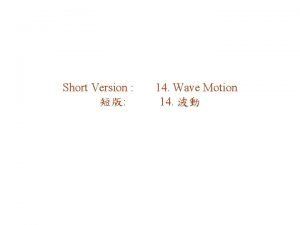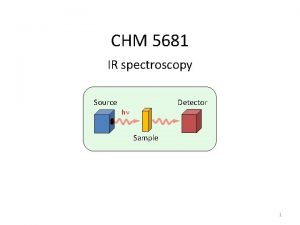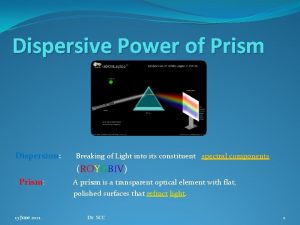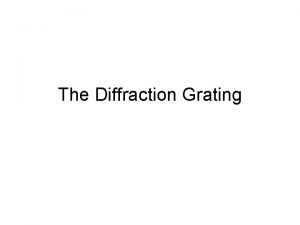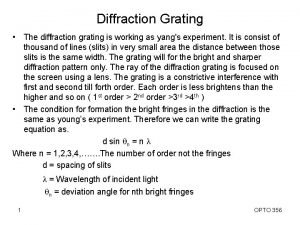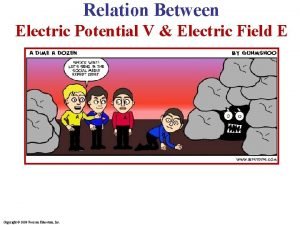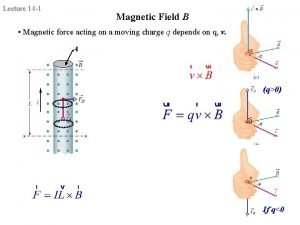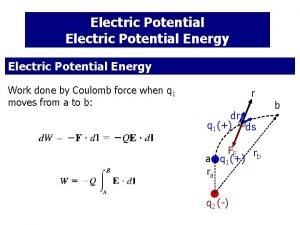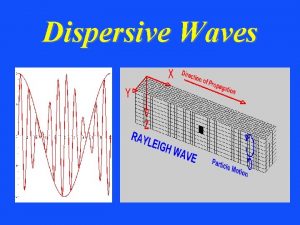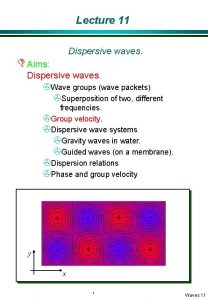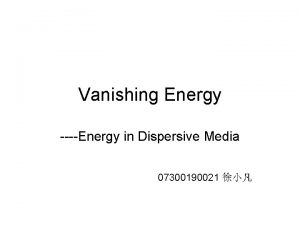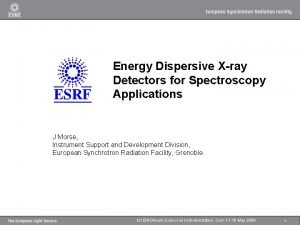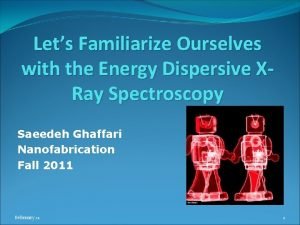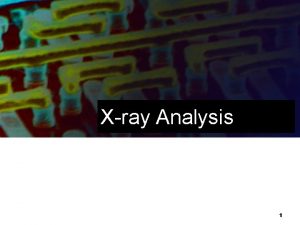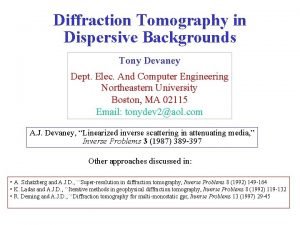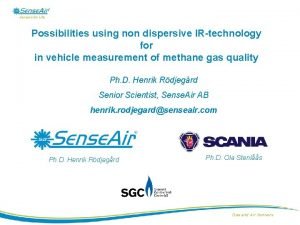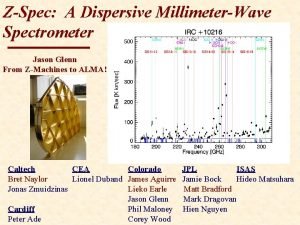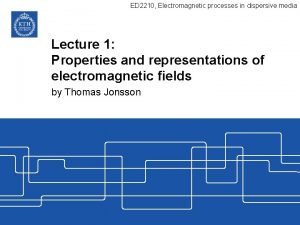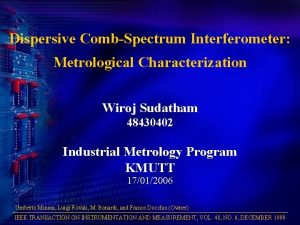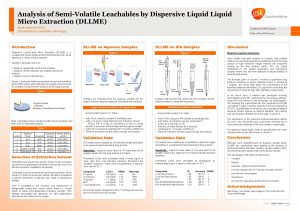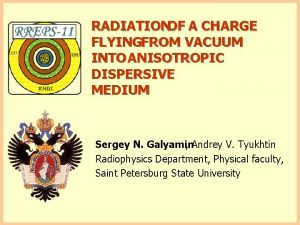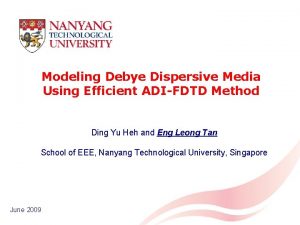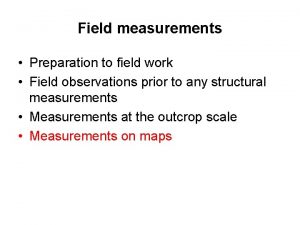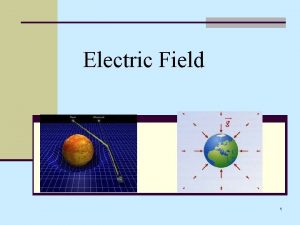Field energy in a dispersive medium Section 80




























- Slides: 28

Field energy in a dispersive medium Section 80

1. The expression and significance for the Energy Flux Density (Poynting Vector) are valid under all conditions. This formula has been shown to hold in • vacuum (volume 2. ) • in metals at zero frequency (v. 8 section 30) • and in non-dispersive dielectrics (v. 8 section 75). It also holds in variable electromagnetic fields when dispersion is present The component of S normal to a surface involves only Et and Ht, which are both continuous across a boundary. Sn is continuous across boundary Energy flowing from vacuum across boundary must be conserved, so expression for S remains valid for energy flux density in a dispersive dielectric.

This section considers four cases. I. Non-dispersive bodies: Internal energy II. Monochromatic light in dispersive bodies: rate of dissipation III. Non-monochromatic wave packet in dispersive bodies: net dissipation IV. Non-monochromatic wave packet in transparent dispersive body: Build up of internal energy

2. Case I: non-dispersive bodies (75. 15): rate of change of energy per unit volume Take the real parts of the fields before combining them in this quadratic function For non-dispersive linear media, permittivity and permeability are real constants, no w dependence where = electromagnetic energy density = internal energy difference for body with and without fields, holding entropy and density constant. =total work done by turning on the fields No energy is lost and no heat is generated!

2. Dispersive media dissipate energy. U is not a definite thermodynamic quantity. Dispersive media absorbing energy from the electromagnetic fields. Electromagnetic energy U is not constant unless there is a net inflow of electromagnetic energy.

3. Case II. Monochromatic light in a dispersive medium Mean evolved heat density per unit time Q = <-div. S>t Under conditions of constant field amplitude, there is a constant inflow of energy <d. U/dt>t = <-div. S>t , which is converted to heat at a rate Q

monochromatic fields are conveniently written in complex form E = E 0 e-iwt An increment of electromagnetic energy that flows into unit volume is d. U = (E. d. D +H. d. B)/4 p. Some flows out the other side. Some remains as heat = <d. U>t (We can’t write U itself as a definite quantity because of dissipation, but we can talk about changes in U. ) The rate of inflow of electromagnetic energy density is d. U/dt = Use real fields in non-linear functions Now take time average to find rate of heat generation Q per unit volume.

Products E. E and E*. E* contain oscillating factors Oscillations disappear from products E. E*, so those remain after time averaging Complex fields used here. Dissipation of field energy per unit time is determined by imaginary parts e” and m”. These are positive by 2 nd Law. Real fields used here

Recipe: For monochromatic light, e. g. CO 2 laser light, dissipation is determined by the value of e” at the corresponding frequency. 60. 2

4. But what are you going to do if the light is not monochromatic? Rate of heat generation is not constant since amplitude of nonmonochromatic field is slowly time varying, see LL 2 sec 50. What value of e” would you use? The average? LWIR Conversion of broad band infrared radiation to heat is an important practical problem Proc. SPIE 9819 – 50 (2016).

Case III: non-monochromatic fields in dispersive medium We consider a pulse or wavepacket that goes to zero sufficiently rapidly as t ®±¥ All light emission processes have finite duration. Non-monochromatic Instead of dissipation per unit time, consider time-integrated net dissipation. We have to do this because dissipative effects depend on the entire history of the fields An expression for instantaneous rate of energy dissipation isn’t possible in this case.

5. Finding the formula for total heat generated per unit volume in a medium by an electromagnetic pulse. Any time dependent field can be written as a sum of monochromatic fields: Fourier expansion Required to ensure that the field is real

Electric part of net dissipation is a triple integral

First integrate over w’. Then the delta function changes w’ to -w Total heat generated per unit volume by an electromagnetic pulse This looks just like an integral over frequencies of the monochromatic case. (Ew has units of electric field times time). Since the integrand is even, we don’t actually have to integrate over negative frequencies

6. Electric and magnetic losses are determined by By second law and may be positive or negative No restriction

7. Transparency ranges are spectral bands where losses are very small e” and m” are never zero except at w = 0. However, they may be very small e”<<|e’| Then, neglect absorption. Now we can talk about definite internal energy of linear media as in the static case, except now it is not constant. In static case, these were real constants independent of w For electromagnetic waves in a transparent dispersive medium, we don’t simply replace the constants e and m by the functions e(w) and m(w). It’s more complicated.

Energy density U doesn’t change in transparent media for purely monochromatic fields, because their amplitudes are unchanged since the dawn until the end of time. Consider nearly monochromatic wavepacket with a narrow range of frequencies These amplitudes vary slowly compared with the “carrier” Long smooth pulse

Rate of change of energy in unit volume Substitute the real parts of the fields Next, average over the short period The electric part is Are ~constant over this period.

Products Time average to zero due to fast oscillating factors Leaving In these remaining terms, fast oscillating factor disappears and there is no variation to average: Drop the <> We need the time derivatives of D and D*. The electric induction is Integral operator

This is an integraldifferential operator If = constant. This is the zeroth approximation, where nearly monochromatic wave is assumed perfectly monochromatic. for monochromatic fields

Next approximation: Smoothly varying nearly monochromatic wave packet. Expand the slowly varying amplitude as its own Fourier series. Only small frequencies a << w 0 appear in the expansion of the amplitude, since its variations are slow compared to the carrier w 0. We will consider just one of the Fourier components in this expansion for now:

Considering only the ath Fourier component in the expansion of E 0(t) The operator f is now acting on a monochromatic wave Taylor expand f(a + w 0) about a = 0.

Now sum the Fourier components for the amplitude. Drop subscript on w 0

Substitute into neglect e” in transparency regions, so e is real. The two EE* terms cancel leaving Rate of change of electromagnetic energy density Where averaged internal energy has definite value Averaged over fast oscillations Magnetic part added

In terms of the real fields Mean value of the electromagnetic part of the internal energy density of transparent medium

8. Mean value of the electromagnetic part of the internal energy density in a transparent medium Compare to result for static case and for dispersion-less medium (dynamic case 1) If there is no dispersion Usual static result

9. If you cut off the external source of electromagnetic energy, energy in medium must all eventually convert to heat. Second law Then

The formula Was found by expanding d. D/dt to first order in the small frequencies a, which are only small if the amplitude E 0(t) varies slowly. The formula applies to slowly and smoothly varying wave trains, and not to ultra-short (< few-cycle) pulses.
 Non dispersive medium
Non dispersive medium Hot and cold medium
Hot and cold medium Vydj
Vydj What is the definition of chemical potential energy
What is the definition of chemical potential energy Thermal energy section 3 using thermal energy
Thermal energy section 3 using thermal energy Chapter 8 section 1 how organisms obtain energy
Chapter 8 section 1 how organisms obtain energy Energy energy transfer and general energy analysis
Energy energy transfer and general energy analysis Energy energy transfer and general energy analysis
Energy energy transfer and general energy analysis Elastic energy
Elastic energy Electric field and magnetic field difference
Electric field and magnetic field difference Individual differences in second language learning
Individual differences in second language learning Field dependent vs field independent
Field dependent vs field independent Q factor of capacitor
Q factor of capacitor Waveguide cutoff frequency
Waveguide cutoff frequency Database field types and field properties
Database field types and field properties Field dependent definition
Field dependent definition Difference between electric field and magnetic field
Difference between electric field and magnetic field Ring of fire
Ring of fire Mobile ka
Mobile ka Dispersive ir spectroscopy
Dispersive ir spectroscopy Dispersive power is dependent on
Dispersive power is dependent on Dispersive power of grating
Dispersive power of grating Resolving power of grating
Resolving power of grating Repeating disturbance that transfers energy
Repeating disturbance that transfers energy V and e relation
V and e relation Phys241
Phys241 Energy electric field equation
Energy electric field equation Potential energy of an electric field
Potential energy of an electric field Potential energy of an electric field
Potential energy of an electric field
